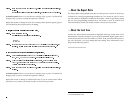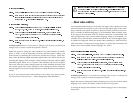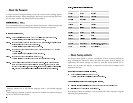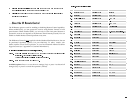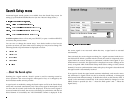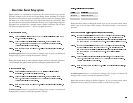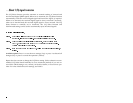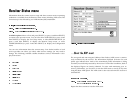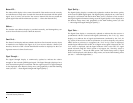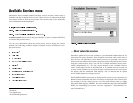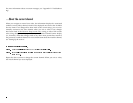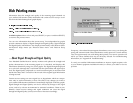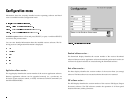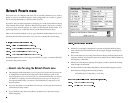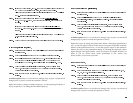
1HWZRUN,'«
The Network ID display is the current Network ID. This number must be correctly
set at the Receiver Setup menu to match the Network ID associated with the uplink
signal. Loss of service will result if the receiver Network ID does not match the
uplink signal Network ID information (see also “…About the Network ID”).
$GGUHVV«
The decoder user address display is provided externally, and distinguishes your
receiver from all other receivers within the network.
6PDUW&DUG«
The Smart Card display indicates whether the Smart Card external security device
is installed or not installed (see Figure 4). If your receiver includes a Smart Card
interface, the device OSE
1
version identification number is displayed at the Con-
figuration menu if a Smart Card is used.
6LJQDO 6WU HQJWK«
The Signal Strength display is continuously updated to indicate the relative
strength of the received QPSK digital signal. The Signal Strength (displayed on a
scale from 00 through 99) is associated with the signal input level. Signal Strength
is also displayed at the Receiver Setup menu, and graphically at the Dish Pointing
menu (see also “…About Signal Strength and Signal Quality”).
1
Outside Security Element
6LJQDO 4XDOLW\«
The Signal Quality display is continuously updated to indicate the relative quality
of the received QPSK digital signal. The Signal Quality (displayed on a scale from 0
through 9) is associated with the Bit Error Rate, and is a measure of how much of
the original signal information is being received. Signal Quality is also displayed at
the Receiver Setup menu, and graphically at the Dish Pointing menu (see also
“…About Signal Strength and Signal Quality”).
6LJQDO 6WDWH«
The Signal State display is continuously updated to indicate that the receiver is
synchronized with the received LNB signal (confirmed by the “Lock, Sig“ status
display), or to indicate loss of signal synchronization (confirmed by the “Lock, No
Sig“ status). If the receiver is able to synchronize to a carrier frequency only and no
MPEG stream is present or is recognized, the “Lock, No Sig“ status is displayed,
and the Signal indicator LED is OFF. If no digital carrier signal is detected, the “No
Lock“ status is displayed, and the Signal indicator LED is also OFF. If a signal
search activated using the “Find” option is in progress, the “Searching“ status is
displayed (see also “…About the Find option” and “Search Setup menu”). Signal
State is also displayed at the Receiver Setup menu, and at the Dish Pointing menu
(see also “…About the Signal State”).



